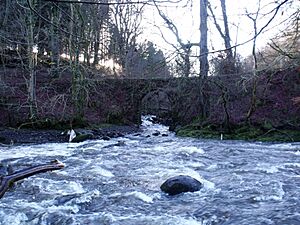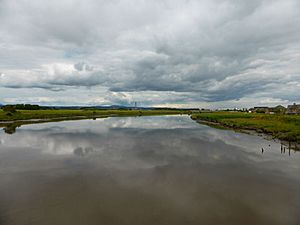River Carron, Forth facts for kids
The Carron (in Gaelic: Carrann) is a river in central Scotland. It starts in the Campsie Fells mountains and flows through a valley called Strathcarron. Eventually, it reaches the Firth of Forth, which is an arm of the sea. The river has given its name to many places in Stirlingshire. It also inspired the name of a type of cannon, a line of bathtubs, two warships, and even an island far away in the Southern Hemisphere.
Contents
Where the River Flows
The Carron River begins in the Campsie Fells. From there, it flows into the Carron Reservoir. Then, it continues along the Strathcarron valley.
The river passes by the town of Denny. After that, it flows between Larbert and Falkirk. It then goes past the village of Carron. Just as the M9 motorway crosses the river, the Forth and Clyde Canal joins it. Finally, the Carron River flows into the Forth near Grangemouth.
Carron Bridge
The Carron Bridge crosses the river at the eastern edge of Strathcarron Forest. It was built in 1695. This bridge replaced an old ford that had been there for hundreds of years. The ford was part of an old path used to move animals from Kilsyth to Stirling.
The bridge has two span stone arches. It looks bigger than it needs to be today. This is because the river was much wider before the Carron Dam was built in the 1930s. The dam created the reservoir.
Carron Valley Reservoir
The Carron Valley Reservoir is a large lake, about 1,000 acres in size. It was finished in 1939. This reservoir is a great place for fishing. It is stocked with brown trout by the Carron Valley Fishery.
The reservoir has become a perfect home for the Carron River's native brown trout. The "wild brownies" (as they are called) thrive there. They find lots of food in the newly flooded valley. They also have easy access to many good streams for laying eggs and for young fish to grow.
The Carron Works
The Carron Company was a famous ironworks factory. It was started in 1759. The factory was built on the north bank of the Carron River, about two miles downstream from Falkirk. This company was very important during the Industrial Revolution in Britain.
The company also had its own coal mines. These were known as the "Carron Collieries." The villages of Carronhall and Carronshore had homes for the miners and factory workers. A special railway line, the Carron Branch Railway, served this area.
One of the most famous products from the factory was a ship cannon called the carronade. These powerful guns were used in big battles. They were used during the Napoleonic Wars, like the Battle of Trafalgar. They were also used in various naval battles during the American Civil War.
The Carron Company was broken up in 1982. Many parts of the company closed down. However, some parts still exist today. Carron Bathrooms Ltd [1] makes acrylic baths and shower trays. Carron Phoenix [2] makes kitchen sinks.
Warships Named Carronade
The USS Carronade was a ship of the U.S. Navy. It was named after the cannon, which was named after the river. The ship was finished in 1955. It was too late to serve in the Korean War. It was taken out of service but later brought back for the Vietnam War. The ship was taken out of service again in 1969.
Carronade Island
In July 1916, the ship HMAS Encounter was on patrol. It found a small island on the northern coast of Western Australia. The crew discovered two bronze cannons there. They were standing six feet apart and pointing into the air.
At the time, people mistakenly thought these guns were carronades. So, the island was named Carronade Island because of this discovery. For many years, people misunderstood where these guns came from. They were thought to support the idea that Portuguese explorers found Australia first. However, scientists at the Western Australian Museum in Fremantle have studied them carefully. They have found that these weapons are almost certainly from Makassar, not Europe.
Images for kids




